Coburn J.W. Algebra and Trigonometry
Подождите немного. Документ загружается.


930 CHAPTER 10 Analytic Geometry and the Conic Sections 10-12
EXAMPLE 3
Graphing a Horizontal Ellipse
Sketch the graph of
Solution
Noting we have an ellipse with
center The horizontal
distance from the center to the graph is
and the vertical distance from the
center to the graph is After plotting
the corresponding points and connecting
them with a smooth curve, we obtain the
graph shown.
Now try Exercises 19 through 24
As with the circle, the equation of an ellipse can be given in polynomial form, and
here our knowledge of circles is helpful. For the equation , we know
the graph cannot be a circle since the coefficients are unequal, and the center of the
graph must be at the origin since . To actually draw the graph, we convert
the equation to standard form.
EXAMPLE 4
Graphing a Vertical Ellipse
For (a) write the equation in standard form and identify the
center and the values of a and b, (b) identify the major and minor axes and name
the vertices, and (c) sketch the graph.
Solution
The coefficients of x
2
and y
2
are unequal, and 25, 4, and 100 have like signs. The
equation represents an ellipse with center at (0, 0). To obtain standard form:
a.
given equation
divide by 100
standard form
write denominators in squared form;
b. The result shows and indicating the major axis will be vertical and
the minor axis will be horizontal. With the center at the origin, the x-intercepts will
be (2, 0) and with the vertices (and y-intercepts) at (0, 5) and
c. Plotting these intercepts and sketching the ellipse results in the graph shown.
Now try Exercises 25 through 36
x
y
(0, 5)
(2, 0)
(0, 5)
(2, 0)
Vertical ellipse
Center at (0, 0)
Endpoints of major axis (vertices)
(0, 5) and (0, 5)
Endpoints of minor axis
(2, 0) and (2, 0)
Length of major axis 2b: 2(5) 10
Length of minor axis 2a: 2(2) 4
a 2
b 5
10, 52.12, 02,
b 5,a 2
a 2, b 5
x
2
2
2
y
2
5
2
1
x
2
4
y
2
25
1
25x
2
100
4y
2
100
1
25x
2
4y
2
100
25x
2
4y
2
100,
h k 0
25x
2
4y
2
100
b 3.
a 5,
1h, k2 12, 12.
a b,
1x 22
2
25
1y 12
2
9
1.
(2, 1)
(2, 4)
(3, 1)
(2, 2)
Ellipse
(7, 1)
y
a 5
b 3
x
WORTHY OF NOTE
In general, for the equation
(),
the equation represents a
circle if , and an ellipse
if .A B
A B
A, B, F 7 0Ax
2
By
2
F
College Algebra & Trignometry—
cob19529_ch10_0928-0940.qxd 12/6/08 12:44 AM Page 930 epg HD 049 :Desktop Folder:Satya 05/12/08:
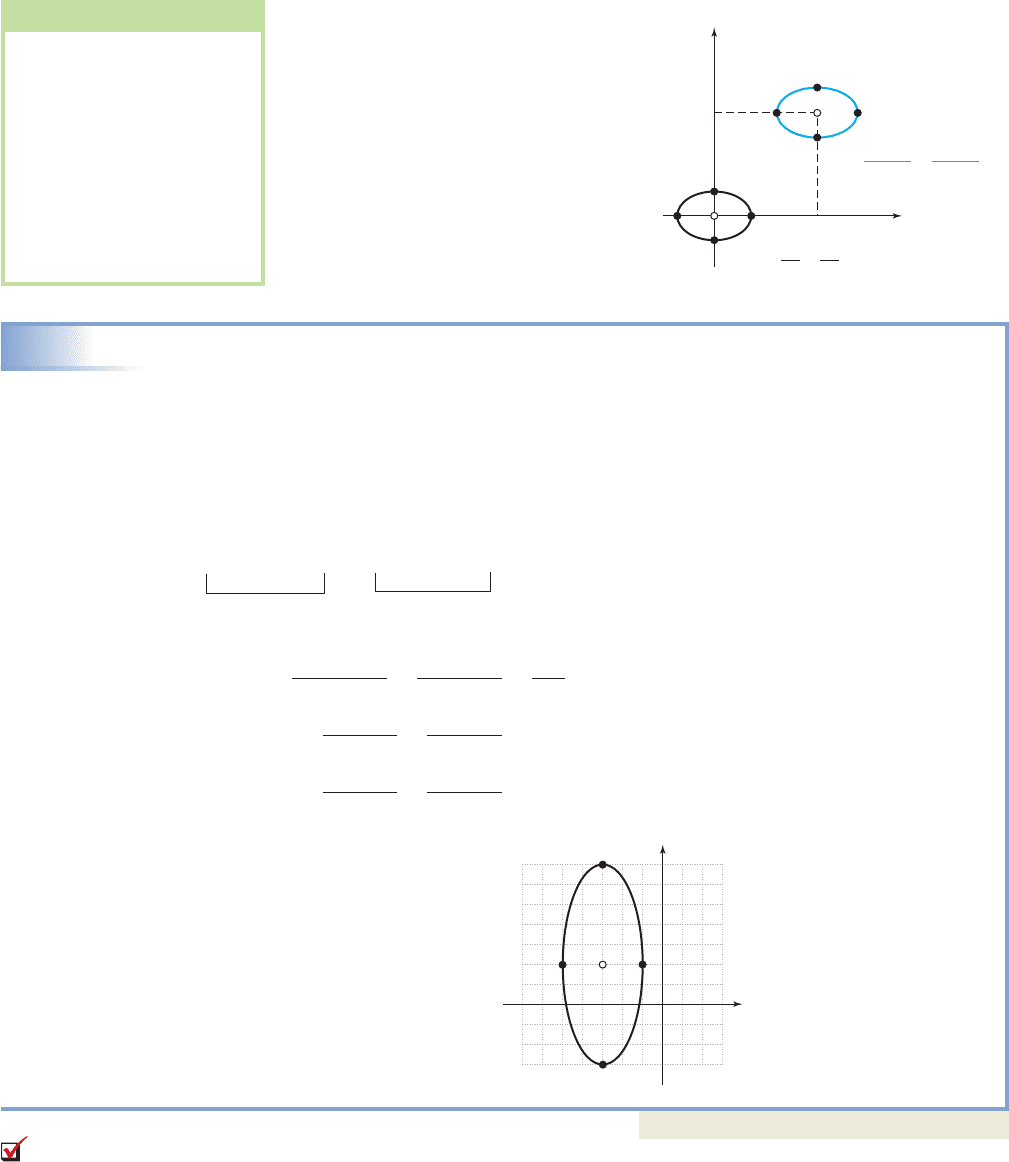
10-13 Section 10.2 The Circle and the Ellipse 931
If the center of the ellipse is not
at the origin, the polynomial form has
additional linear terms and we must
first complete the square in x and y,
then write the equation in standard
form to sketch the graph (see the
Reinforcing Basic Concepts feature
for more on completing the square).
Figure 10.14 illustrates how the
central ellipse and the shifted ellipse
are related.
EXAMPLE 5
Completing the Square to Graph an Ellipse
Sketch the graph of
Solution
The coefficients of x
2
and y
2
are unequal and have like signs, and we assume the equation
represents an ellipse but wait until we have the factored form to be certain.
given equation (polynomial form)
group like terms; subtract 141
factor out leading coefficient from each group
complete the square
adds adds
add to right
factor
divide both sides by 100
simplify (standard form)
write denominators in squared form
The result is a vertical ellipse with
center at with and
The vertices are a vertical
distance of 5 units from center, and
the endpoints of the minor axis are
a horizontal distance of 2 units from
center.
Note this is the same ellipse as
in Example 4, but shifted 3 units
left and 2 up.
Now try Exercises 37 through 44
C. The Foci of an Ellipse
In Section 10.1, we noted that an ellipse could also be defined in terms of two special
points called the foci. The Museum of Science and Industry in Chicago, Illinois
(http://www.msichicago.org), has a permanent exhibit called the Whispering
Gallery. The construction of the room is based on some of the reflective properties
of an ellipse. If two people stand at designated points in the room and one of them
b 5.
a 213, 22,
1x 32
2
2
2
1y 22
2
5
2
1
1x 32
2
4
1y 22
2
25
1
251x 32
2
100
41y 22
2
100
100
100
251x 32
2
41y 22
2
100
225 16
4142 1625192 225
251x
2
6x 92 41y
2
4y 42141 225 16
251x
2
6x
__
2 41y
2
4y
__
2141
25x
2
150x 4y
2
16y 141
25x
2
4y
2
150x 16y 141 0
25x
2
4y
2
150x 16y 141 0.
WORTHY OF NOTE
After writing the equation in
standard form, it is possible
to end up with a constant
that is zero or negative. In the
first case, the graph is a
single point. In the second
case, no graph is possible
since roots of the equation
will be complex numbers.
These are called degenerate
cases. See Exercise 78.
c
c
cc
Ellipse with center
at (h, k)
All points shift
h units horizontally,
k units vertically,
opposite the sign
x
2
a
2
a b
a b
(0, b)
(a, 0)
(0, b)
(a, 0)
y
2
b
2
1
a
2
(x h)
2
1
b
2
(y k)
2
h
k
(h, k)
(0, 0)
x
y
Central
ellipse
Figure 10.14
x
y
(3, 7)
(5, 2)
(3, 3)
(1, 2)
(3, 2)
Vertical ellipse
Center at (3, 2)
Endpoints of major axis (vertices)
(3, 3) and (3, 7)
Endpoints of minor axis
(5, 2) and (1, 2)
Length of major axis 2b: 2(5) 10
Length of minor axis 2a: 2(2) 4
B. You’ve just learned
how to use the equation of an
ellipse to graph central and
noncentral ellipses
College Algebra & Trignometry—
cob19529_ch10_0928-0940.qxd 12/6/08 12:44 AM Page 931 epg HD 049 :Desktop Folder:Satya 05/12/08:
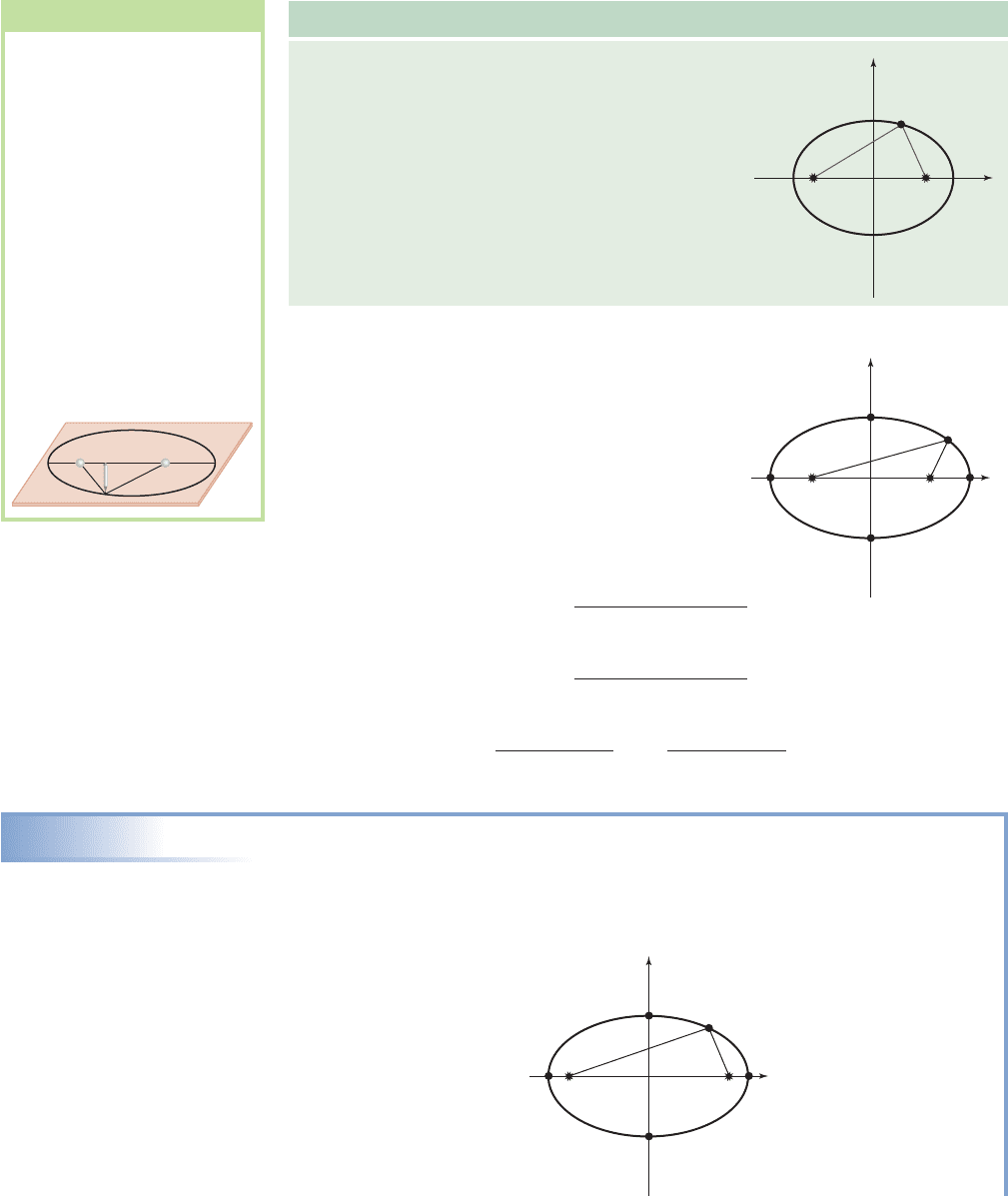
932 CHAPTER 10 Analytic Geometry and the Conic Sections 10-14
whispers very softly, the other person can hear the whisper quite clearly—even
though they are over 40 ft apart! The point where each person stands is a focus of
the ellipse. This reflective property also applies to light and radiation, giving the
ellipse some powerful applications in science, medicine, acoustics, and other areas.
To understand and appreciate these applications, we introduce the analytic defini-
tion of an ellipse.
Definition of an Ellipse
Given two fixed points f
1
and f
2
in a plane, an ellipse
is the set of all points (x, y) where the distance from
f
1
to (x, y) added to the distance from f
2
to (x, y)
remains constant.
The fixed points f
1
and f
2
are called the foci of the
ellipse, and the points P(x, y) are on the graph of the
ellipse.
To find the equation of an ellipse in terms of
a and b we combine the definition just given with
the distance formula. Consider the ellipse shown
in Figure 10.15 (for calculating ease we use a
central ellipse). Note the vertices have coordi-
nates and (a, 0), and the endpoints of the
minor axis have coordinates and (0, b) as
before. It is customary to assign foci the coordi-
nates and We can cal-
culate the distance between (c, 0) and any point
P(x, y) on the ellipse using the distance formula:
Likewise the distance between and any point (x, y) is
According to the definition, the sum must be constant:
EXAMPLE 6
Finding the Value of k from the Definition of an Ellipse
Use the definition of an ellipse and the diagram given to determine the constant k
used for this ellipse following (also see the following Worthy of Note). Note that
, and .
y
x
P(3, 2.4)
(5, 0)
(4, 0)
(4, 0)
(0, 3)
(0, 3)
(5, 0)
c 4a 5, b 3
21x c2
2
y
2
21x c2
2
y
2
k
21x c2
2
1y 02
2
1c, 02
21x c2
2
1y 02
2
f
2
S 1c, 02.f
1
S 1c, 02
10, b2
1a, 02
d
1
d
2
k
x
f
1
d
2
d
1
d
1
d
2
k
P(x, y)
f
2
y
WORTHY OF NOTE
You can easily draw an
ellipse that satisfies the defi-
nition. Press two pushpins
(these form the foci of the
ellipse) halfway down into a
piece of heavy cardboard
about 6 in. apart. Take an
8-in. piece of string and loop
each end around the pins.
Use a pencil to draw the
string taut and keep it taut as
you move the pencil in a
circular motion—and the
result is an ellipse! A different
length of string or a different
distance between the foci will
produce a different ellipse.
6 in.
8 in.
Figure 10.15
y
x
P(x, y)
(a, 0)
(c, 0) (c, 0)
(0, b)
(0, b)
(a, 0)
College Algebra & Trignometry—
cob19529_ch10_0928-0940.qxd 12/6/08 12:44 AM Page 932 epg HD 049 :Desktop Folder:Satya 05/12/08:
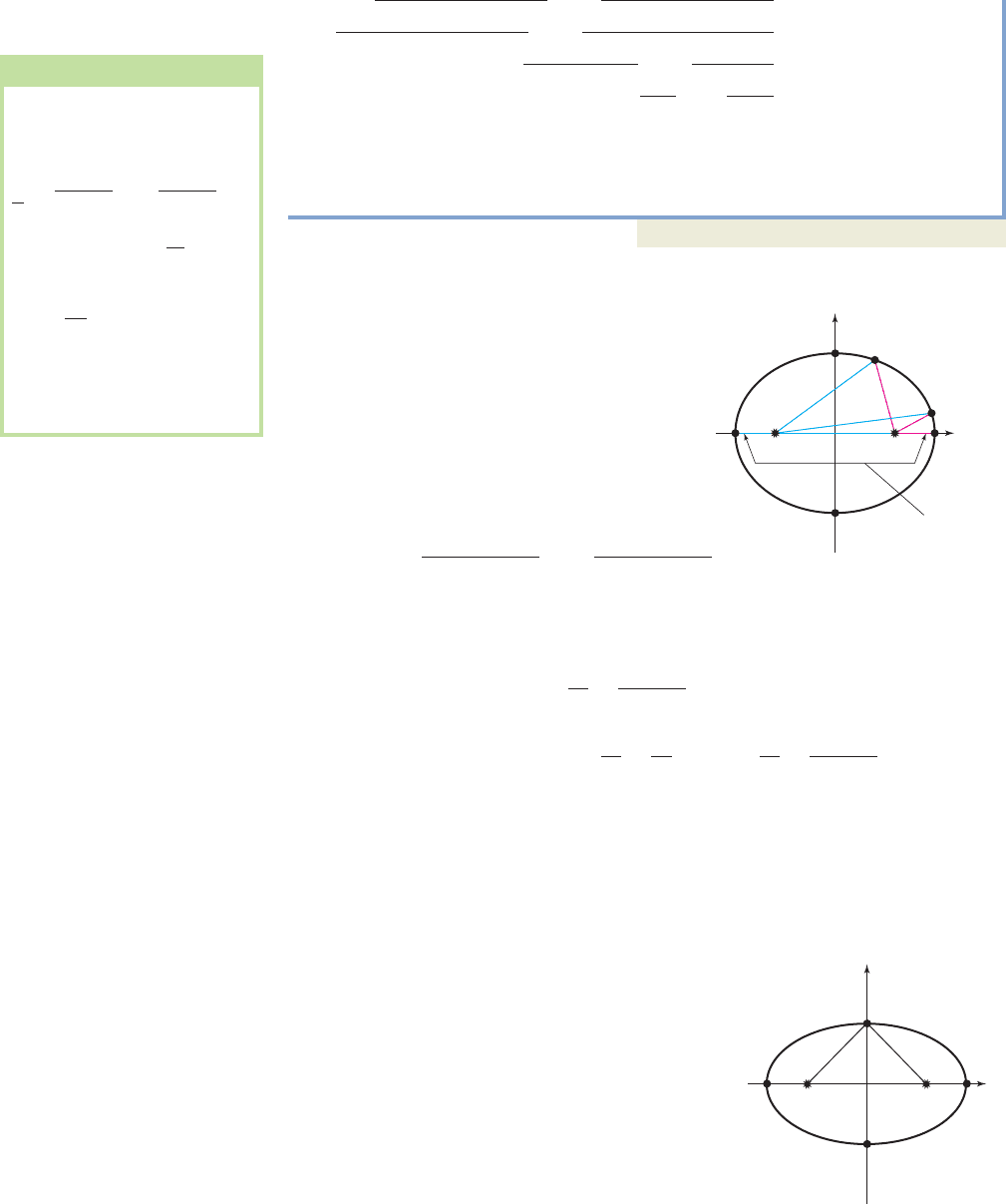
10-15 Section 10.2 The Circle and the Ellipse 933
Solution
given
substitute
add
simplify radicals
compute square roots
result
The constant used for this ellipse is 10 units.
Now try Exercises 45 through 48
In Example 6, the sum of the distances
could also be found by moving the point
(x, y) to the location of a vertex (a, 0), then
using the symmetry of the ellipse. The sum is
identical to the length of the major axis, since
the overlapping part of the string from (c, 0)
to (a, 0) is the same length as from ( , 0) to
( , 0) (see Figure 10.16). This shows the
constant k is equal to 2a regardless of the
distance between foci.
As we noted, the result is
substitute 2a for k
The details for simplifying this expression are given in Appendix III, and the result
is very close to the standard form seen previously:
By comparing the standard form with , we might
suspect that and this is indeed the case. Note from Example 6 the
relationship yields
Additionally, when we consider that (0, b) is
a point on the ellipse, the distance from (0, b) to
(c, 0) must be equal to a due to symmetry (the
“constant distance” used to form the ellipse is
always 2a). We then see in Figure 10.17, that
(Pythagorean Theorem), yielding
as above.
With this development, we now have the
ability to locate the foci of any ellipse—an
important step toward using the ellipse in prac-
tical applications. Because we’re often asked to
find the location of the foci, it’s best to rewrite
the relationship in terms of c
2
, using absolute value bars to allow for a major axis that
is vertical: c
2
a
2
b
2
.
b
2
a
2
c
2
b
2
c
2
a
2
9 25 16
3
2
5
2
4
2
b
2
a
2
c
2
b
2
a
2
c
2
,
x
2
a
2
y
2
a
2
c
2
1
x
2
a
2
y
2
b
2
1
x
2
a
2
y
2
a
2
c
2
1
21x c2
2
y
2
21x c2
2
y
2
2a
c
a
10 k
2.6 7.4 k
16.76
154.76 k
2112
2
2.4
2
27
2
2.4
2
k
213 42
2
12.4 02
2
213 42
2
12.4 02
2
k
21x c2
2
1y 02
2
21x c2
2
1y 02
2
k
WORTHY OF NOTE
Note that if the foci are
coincident (both at the origin)
the “ellipse” will actually
be a circle with radius
leads to . In
Example 1 we found ,
giving , and if we used
the “string” to draw the
circle, the pencil would be
5 units from the center,
creating a circle of radius 5.
10
2
5
k 10
x
2
y
2
k
2
4
k
2
; 2x
2
y
2
2x
2
y
2
k
y
x
(a, 0)
(c, 0) (c, 0)
These two segments are
equal:
d
1
d
2
2a
(a, 0)
d
2
d
1
Figure 10.16
y
x
aa
b
(a, 0)
(c, 0) (c, 0)
(0, b)
(0, b)
(a, 0)
Figure 10.17
College Algebra & Trignometry—
cob19529_ch10_0928-0940.qxd 12/6/08 12:44 AM Page 933 epg HD 049 :Desktop Folder:Satya 05/12/08:
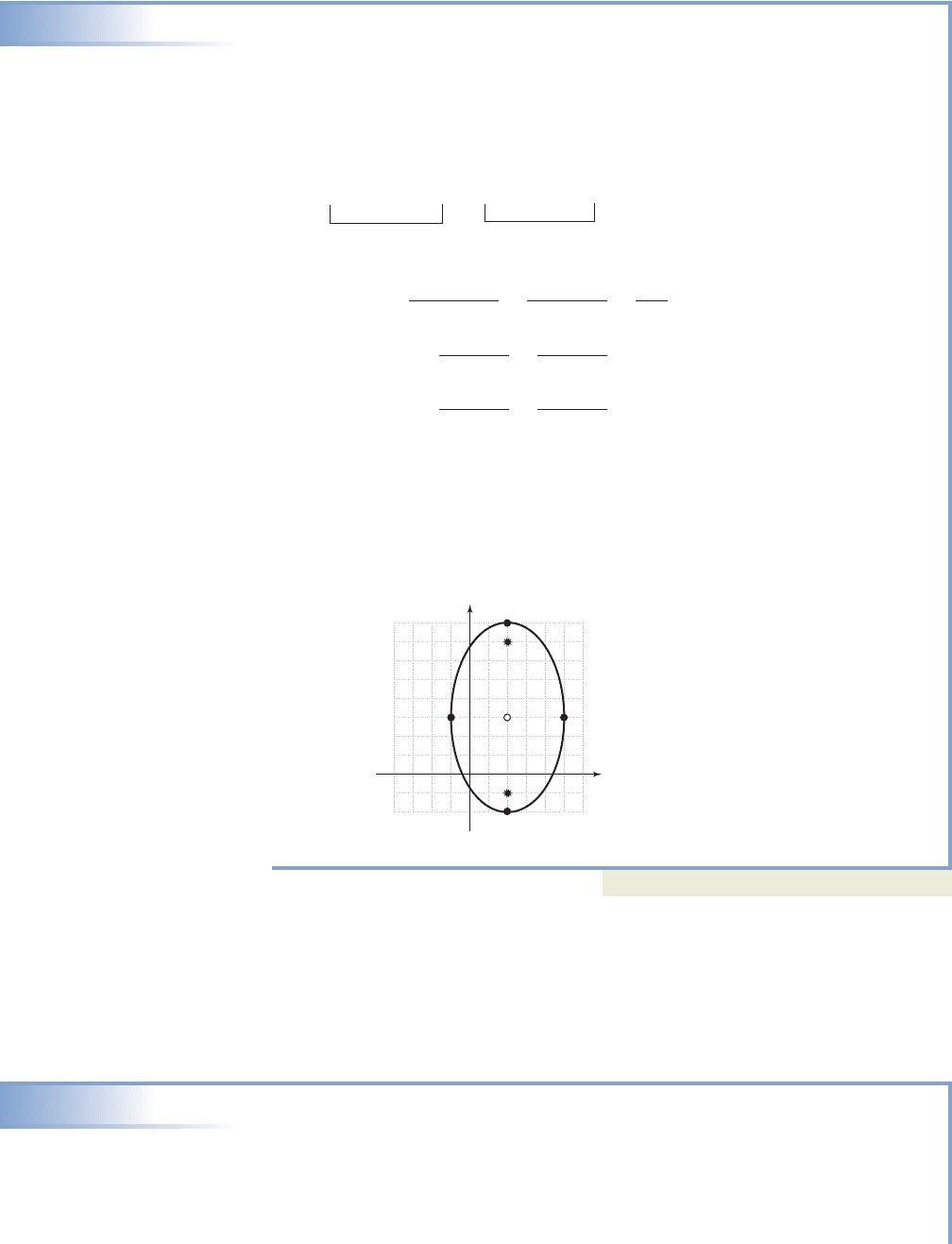
934 CHAPTER 10 Analytic Geometry and the Conic Sections 10-16
EXAMPLE 7
Completing the Square to Graph an Ellipse and Locate the Foci
For the ellipse defined by find the coordinates
of the center, vertices, foci, and endpoints of the minor axis. Then sketch the graph.
Solution
given
group terms; add 44
factor out lead coefficients
adds adds
add to right-hand side
factored form
divide by 225
simplify (standard form)
write denominators
in squared form
The result shows a vertical ellipse with and . The center of the ellipse
is at (2, 3). The vertices are a vertical distance of units from center at (2, 8)
and (2, ). The endpoints of the minor axis are a horizontal distance of
units from center at ( , 3) and (5, 3). To locate the foci, we use the foci formula
for an ellipse: giving This shows the foci “✹”
are located a vertical distance of 4 units from center at (2, 7) and (2, ).
Now try Exercises 49 through 54
For future reference, remember the foci of an ellipse always occur on the major
axis, with and for a horizontal ellipse. This makes it easier to remem-
ber the foci formula for ellipses: Since a
2
is larger, it must be decreased
by b
2
to equal c
2
.
If any two of the values for a, b, and c are known, the relationship between them
can be used to construct the equation of the ellipse.
EXAMPLE 8
Finding the Equation of an Ellipse
Find the equation of the ellipse (in standard form) that has foci at (0, ) and
(0, 2), with a minor axis 6 units in length.
Solution
Since the foci must be on the major axis, we know this is a vertical and central
ellipse with and The minor axis has a length of units,
meaning and To find use the foci equation and solve.b
2
,a
2
9.a 3
2a 6c
2
4.c 2
2
c
2
a
2
b
2
.
a
2
7 c
2
a 7 c
x
y
(2, 2)
(2, 3)
(2, 1)
(2, 8)
(2, 7)
(5, 3)
(1, 3)
Vertical ellipse
Center at (2, 3)
Endpoints of major axis (vertices)
(2, 8) and (2, 2)
Endpoints of minor axis
(1, 3) and (5, 3)
Location of foci
(2, 7) and (2, 1)
Length of major axis: 2b 2(5) 10
Length of minor axis: 2a 2(3) 6
1
c
2
3
2
5
2
16.c
2
a
2
b
2
,
1
a 32
b 5
b 5a 3
1x 22
2
3
2
1y 32
2
5
2
1
1x 22
2
9
1y 32
2
25
1
251x 22
2
225
91y 32
2
225
225
225
251x 22
2
91y 32
3
225
100 81
9192 8125142 100
251x
2
4x 42 91y
2
6y 92 44 100 81
251x
2
4x
__
2 91y
2
6y
__
2 44
25x
2
100x 9y
2
54y 44
25x
2
9y
2
100x 54y 44 0
25x
2
9y
2
100x 54y 44 0,
c
c
cc
College Algebra & Trignometry—
cob19529_ch10_0928-0940.qxd 12/6/08 12:44 AM Page 934 epg HD 049 :Desktop Folder:Satya 05/12/08:
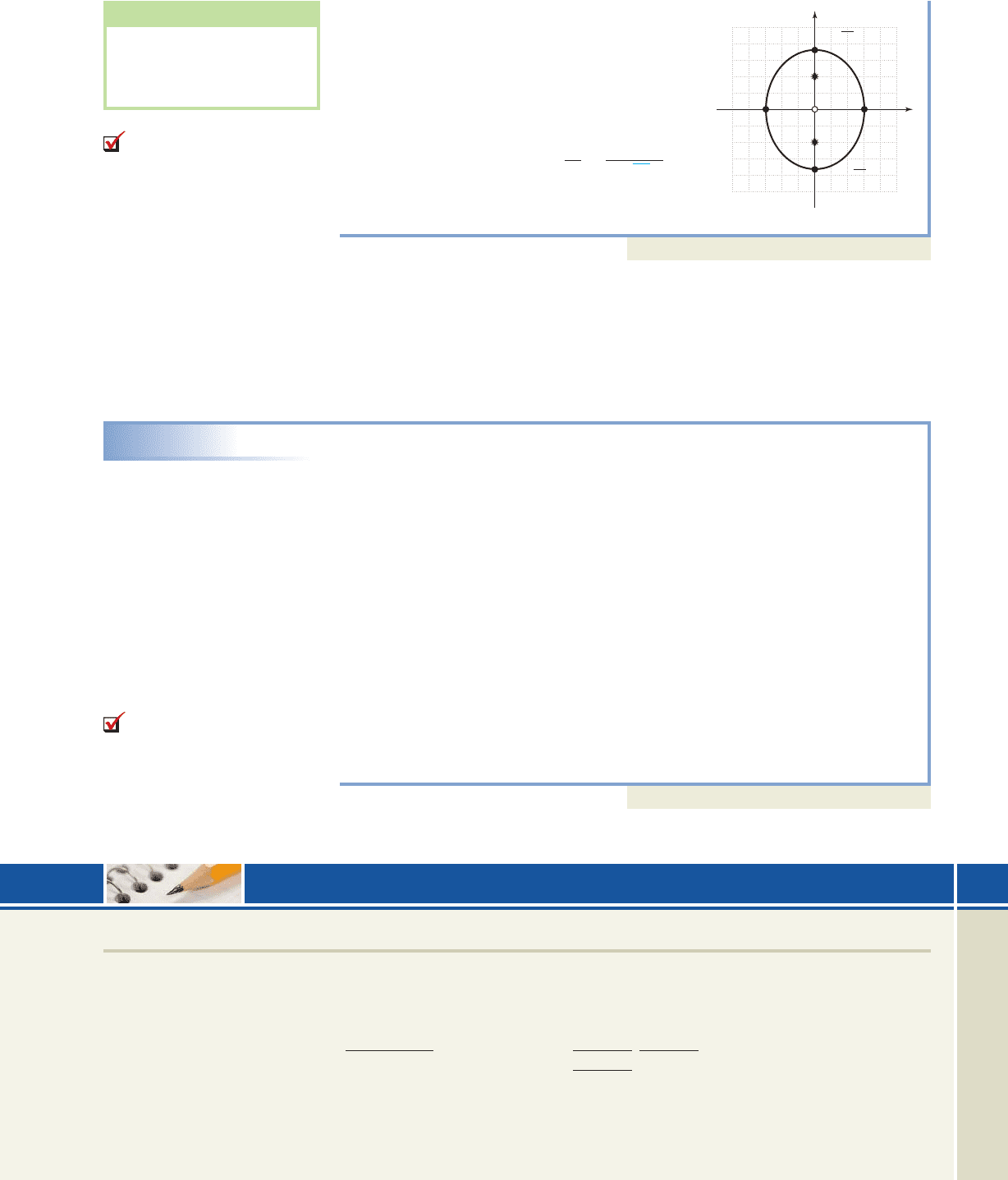
10-17 Section 10.2 The Circle and the Ellipse 935
foci equation (ellipse)
substitute
solve
result
Since we know b
2
must be greater than a
2
(the major axis is always longer), can be
discarded. The standard form is
Now try Exercises 55 through 64
D. Applications Involving Foci
Applications involving the foci of a conic section can take various forms. In many
cases, only partial information about the conic section is available and the ideas from
Example 8 must be used to “fill in the gaps.” In other applications, we must rewrite a
known or given equation to find information related to the values of a, b, and c.
EXAMPLE 9
Solving Applications Using the Characteristics of an Ellipse
In Washington, D.C., there is a park called the Ellipse located between the White
House and the Washington Monument. The park is surrounded by a path that forms
an ellipse with the length of the major axis being about 1502 ft and the minor axis
having a length of 1280 ft. Suppose the park manager wants to install water
fountains at the location of the foci. Find the distance between the fountains
rounded to the nearest foot.
Solution
Since the major axis has length we know and
The minor axis has length meaning and
To find c, use the foci equation:
The distance between the water fountains would be
Now try Exercises 65 through 76
213932 786 ft.
c 393 and c 393
154,401
564,001 409,600
c
2
a
2
b
2
b
2
409,600.b 6402b 1280,
a
2
564,001.a 7512a 1502,
x
2
3
2
y
2
12132
2
1.
b
2
5
b
2
5 b
2
13
4 9 b
2
4 9 b
2
4
9 b
2
x
y
(0, 2)
(0, 2)
(3, 0)
(3, 0)
(0, √13)
(0, √13)
c
2
a
2
b
2
LOOKING AHEAD
For the hyperbola, we’ll find
that , and the formula
for the foci of a hyperbola will
be .
c
2
a
2
b
2
c 7 a
C. You’ve just learned how
to locate the foci of an ellipse
and use the foci and other
features to write the equation
D. You’ve just learned
how to solve applications
involving the foci
Fill in the blank with the appropriate word or phrase.
Carefully reread the section if needed.
1. For an ellipse, the relationship between a, b, and c
is given by the foci equation , since
or .c 6 bc 6 a
2. The greatest distance across an ellipse is called the
and the endpoints are called
.
10.2 EXERCISES
CONCEPTS AND VOCABULARY
College Algebra & Trignometry—
cob19529_ch10_0928-0940.qxd 12/30/08 23:14 Page 935

936 CHAPTER 10 Analytic Geometry and the Conic Sections 10-18
DEVELOPING YOUR SKILLS
Find the equation of a circle satisfying the conditions given.
7. center (0, 0), radius 7
8. center (0, 0), radius 9
9. center (5, 0), radius
10. center (0, 4), radius
11. diameter has endpoints (4, 9) and ( , 1)
12. diameter has endpoints ( , and (3, 9)
Identify the center and radius of each circle, then
sketch its graph.
13.
14.
15.
16.
17.
18.
Sketch the graph of each ellipse.
19.
20.
21.
22.
23.
24.
1x 12
2
36
1y 32
2
9
1
1x 12
2
16
1y 22
2
9
1
1x 52
2
1
1y 22
2
16
1
1x 22
2
25
1y 32
2
4
1
1x 32
2
4
1y 12
2
25
1
1x 12
2
9
1y 22
2
16
1
x
2
y
2
8y 5 0
x
2
y
2
6x 5 0
x
2
y
2
4x 6y 3 0
x
2
y
2
4x 10y 4 0
x
2
y
2
8x 6y 11 0
x
2
y
2
12x 10y 52 0
2, 32
2
15
13
For each exercise, (a) write the equation in standard
form, then identify the center and the values of a and b,
(b) state the coordinates of the vertices and the
coordinates of the endpoints of the minor axis, and
(c) sketch the graph.
25. 26.
27. 28.
29. 30.
Identify each equation as that of an ellipse or circle,
then sketch its graph.
31.
32.
33.
34.
35.
36.
Complete the square in both x and y to write each
equation in standard form. Then draw a complete graph
of the relation and identify all important features.
37.
38.
39.
40.
41.
42.
43.
44. 6x
2
3y
2
24x 18y 3 0
2x
2
5y
2
12x 20y 12 0
4x
2
9y
2
16x 18y 11 0
5x
2
2y
2
20y 30x 75 0
3x
2
y
2
8y 12x 8 0
x
2
4y
2
8y 4x 8 0
x
2
3y
2
8x 7 0
4x
2
y
2
6y 5 0
251x 32
2
41y 22
2
100
41x 12
2
91y 42
2
36
1x 62
2
y
2
49
21x 22
2
21y 42
2
18
91x 22
2
1y 32
2
36
1x 12
2
41y 22
2
16
3x
2
7y
2
212x
2
5y
2
10
25x
2
9y
2
22516x
2
9y
2
144
9x
2
y
2
36x
2
4y
2
16
3. For a vertical ellipse, the length of the minor axis is
and the length of the major axis is .
4. To write the equation in
standard form, the in x.
2x
2
y
2
6x 7
College Algebra & Trignometry—
5. Explain/Discuss how the relations ,
and affect the graph of a conic section with
equation .
1x h2
2
a
2
1y k2
2
b
2
1
a 6 b
a ba 7 b
6. Suppose foci are located at ( , 2) and (5, 2).
Discuss/Explain the conditions necessary for the
graph to be an ellipse.
3
cob19529_ch10_0928-0940.qxd 12/30/08 23:14 Page 936
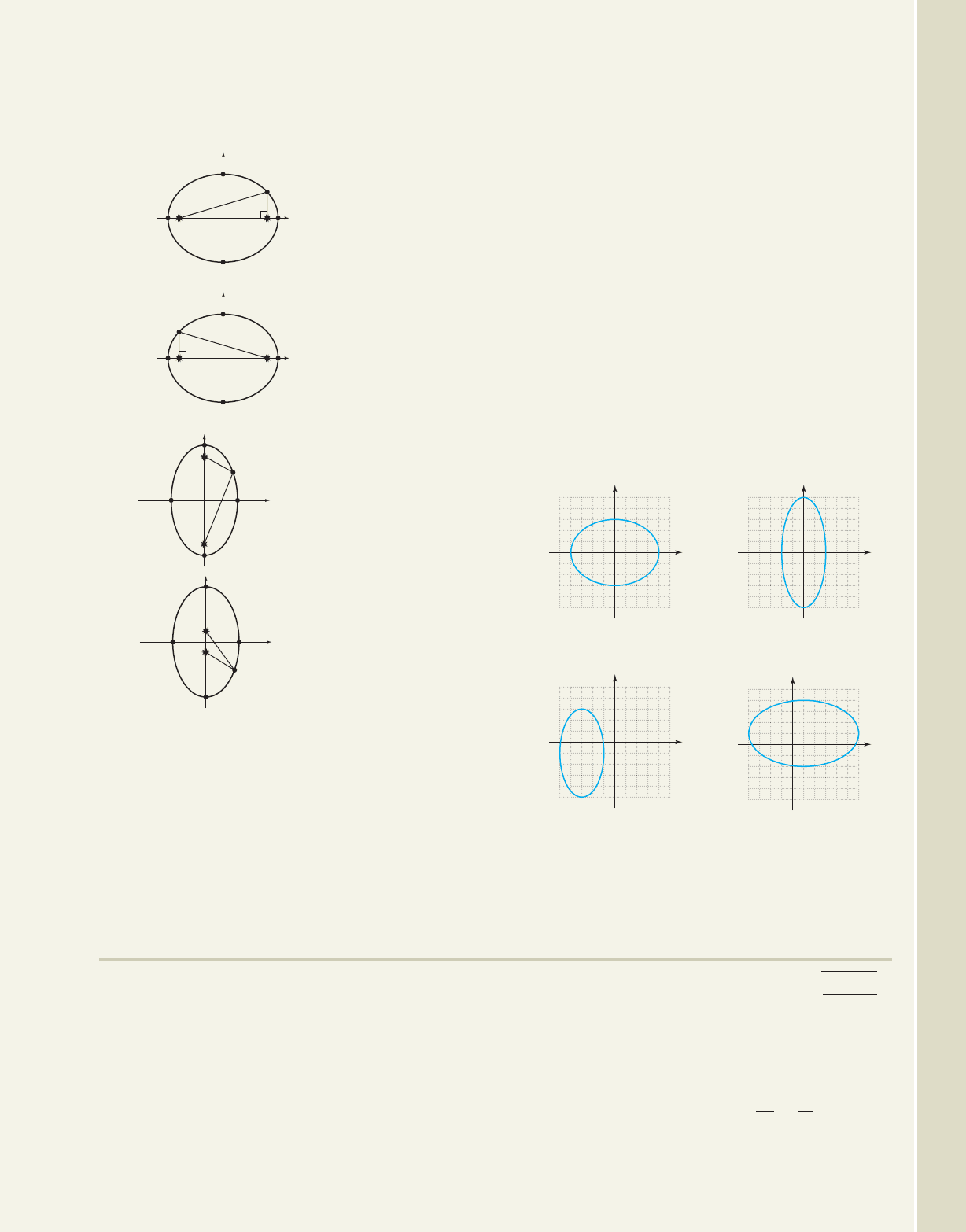
10-19 Section 10.2 The Circle and the Ellipse 937
Use the definition of an ellipse to find the constant k
used for each ellipse (figures are not drawn to scale).
45.
46.
47.
48.
Find the coordinates of the (a) center, (b) vertices,
(c) foci, and (d) endpoints of the minor axis. Then
(e) sketch the graph.
49.
50.
51.
52. 49x
2
4y
2
196x 40y 100 0
25x
2
16y
2
200x 96y 144 0
9x
2
16y
2
54x 64y 1 0
4x
2
25y
2
16x 50y 59 0
(0, 28)
(0, 28)
(76.8, 60)
(0, b)
(0, b)
(96, 0)
(96, 0)
y
x
(0, 8)
(0, 8)
(4.8, 6)
(0, b)
(0, b)
(6, 0)
(6, 0)
y
x
(a, 0)
(9, 0) (9, 0)
(9, 9.6)
(0, 12)
(0, 12)
(a, 0)
y
x
(a, 0)
(6, 0) (6, 0)
(6, 6.4)
(0, 8)
(0, 8)
(a, 0)
y
x
53.
54.
Find the equation of an ellipse (in standard form) that
satisfies the following conditions:
55. vertices at ( , 0) and (6, 0); foci at ( , 0)
and (4, 0)
56. vertices at ( , 0) and (8, 0); foci at ( , 0)
and (5, 0)
57. foci at (3, ) and (3, 2); length of minor axis:
6 units
58. foci at ( ) and (8, ); length of minor axis:
8 units
Use the characteristics of an ellipse and the graph given
to write the related equation and find the location of
the foci.
59. 60.
61. 62.
y
x
y
x
y
x
y
x
34, 3
6
58
46
5x
2
50x 2y
2
12y 93 0
6x
2
24x 9y
2
36y 6 0
63. Area of an Ellipse:
The area of an ellipse is given by the formula
shown, where a is the distance from the center to
the graph in the horizontal direction and b is the
distance from center to graph in the vertical
direction. Find the area of the ellipse defined by
16x
2
9y
2
144.
A ab
64. The Perimeter of an Ellipse:
The perimeter of an ellipse can be approximated by
the formula shown, where a represents the length
of the semimajor axis and b represents the length
of the semiminor axis. Find the perimeter of the
ellipse defined by the equation
x
2
49
y
2
4
1.
P 2
B
a
2
b
2
2
WORKING WITH FORMULAS
College Algebra & Trignometry—
cob19529_ch10_0928-0940.qxd 12/6/08 12:44 AM Page 937 epg HD 049 :Desktop Folder:Satya 05/12/08:
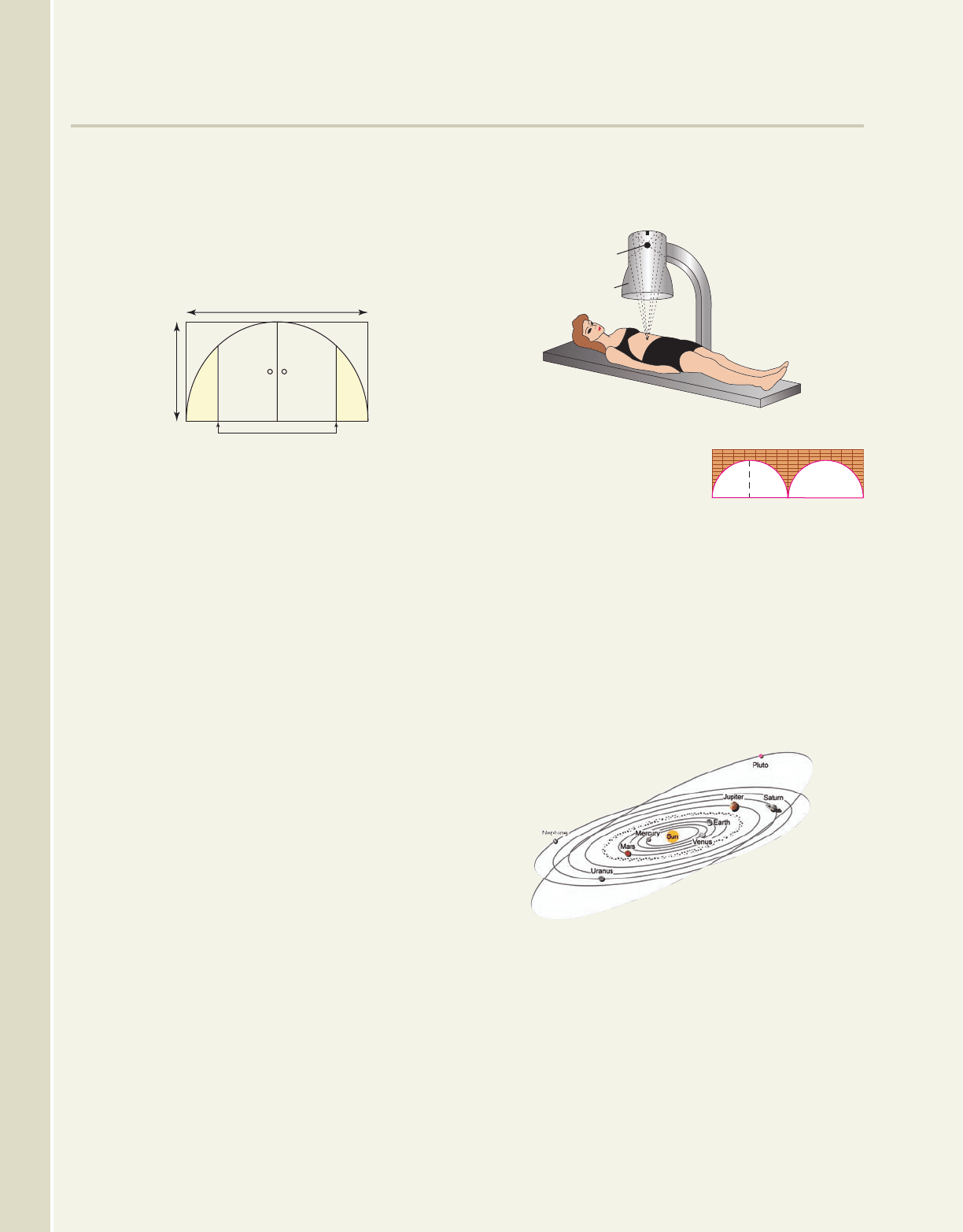
938 CHAPTER 10 Analytic Geometry and the Conic Sections 10-20
APPLICATIONS
65. Decorative fireplaces: A bricklayer intends to build
an elliptical fireplace 3 ft high and 8 ft wide, with
two glass doors that open at the middle. The hinges
to these doors are to be screwed onto a spine that is
perpendicular to the hearth and goes through the foci
of the ellipse. How far from center will the spines be
located? How tall will each spine be?
66. Decorative gardens: A retired math teacher
decides to present her husband with a beautiful
elliptical garden to help celebrate their 50th
anniversary. The ellipse is to be 8 m long and 5 m
across, with decorative fountains located at the
foci. How far from the center of the ellipse should
the fountains be located (round to the nearest 100th
of a meter)? How far apart are the fountains?
67. Attracting attention to art: As part of an art
show, a gallery owner asks a student from the local
university to design a unique exhibit that will
highlight one of the more significant pieces in the
collection, an ancient sculpture. The student
decides to create an elliptical showroom with
reflective walls, with a rotating laser light on a
stand at one focus, and the sculpture placed at the
other focus on a stand of equal height. The laser
light then points continually at the sculpture as it
rotates. If the elliptical room is 24 ft long and 16 ft
wide, how far from the center of the ellipse should
the stands be located (round to the nearest 10th of
a foot)? How far apart are the stands?
68. Medical procedures: The medical procedure
called lithotripsy is a noninvasive medical
procedure that is used to break up kidney
and bladder stones in the body. A machine
called a lithotripter uses its three-dimensional
semielliptical shape and the foci properties of an
ellipse to concentrate shock waves generated at
one focus, on a kidney stone located at the other
focus (see diagram — not drawn to scale). If the
lithotripter has a length (semimajor axis) of 16 cm
and a radius (semiminor axis) of 10 cm, how far
from the vertex should a kidney stone be located
8 ft
Spines
3 ft
Exercise 68
for the best result? Round to the nearest
hundredth.
69. Elliptical arches: In some
situations, bridges are
built using uniform
elliptical archways as
shown in the figure
given. Find the equation of the ellipse forming
each arch if it has a total width of 30 ft and a
maximum center height (above level ground) of
8 ft. What is the height of a point 9 ft to the right
of the center of each arch?
70. Elliptical arches:An elliptical arch bridge is built
across a one lane highway. The arch is 20 ft across
and has a maximum center height of 12 ft. Will a
farm truck hauling a load 10 ft wide with a
clearance height of 11 ft be able to go through the
bridge without damage? (Hint: See Exercise 69.)
As a planet orbits around the Sun, it traces out an
ellipse. If the center of the ellipse were placed at (0, 0)
on a coordinate grid, the Sun would be actually
off-centered (located at the focus of the ellipse). Use
this information and the graphs provided to complete
Exercises 71 through 74.
71. Orbit of Mercury: The approximate orbit of the
planet Mercury is shown in the figure given. Find
an equation that models this orbit.
Focus
Vertex
Lithotripter
60 ft
8 ft
Exercise 69
College Algebra & Trignometry—
cob19529_ch10_0928-0940.qxd 12/6/08 12:44 AM Page 938 epg HD 049 :Desktop Folder:Satya 05/12/08:
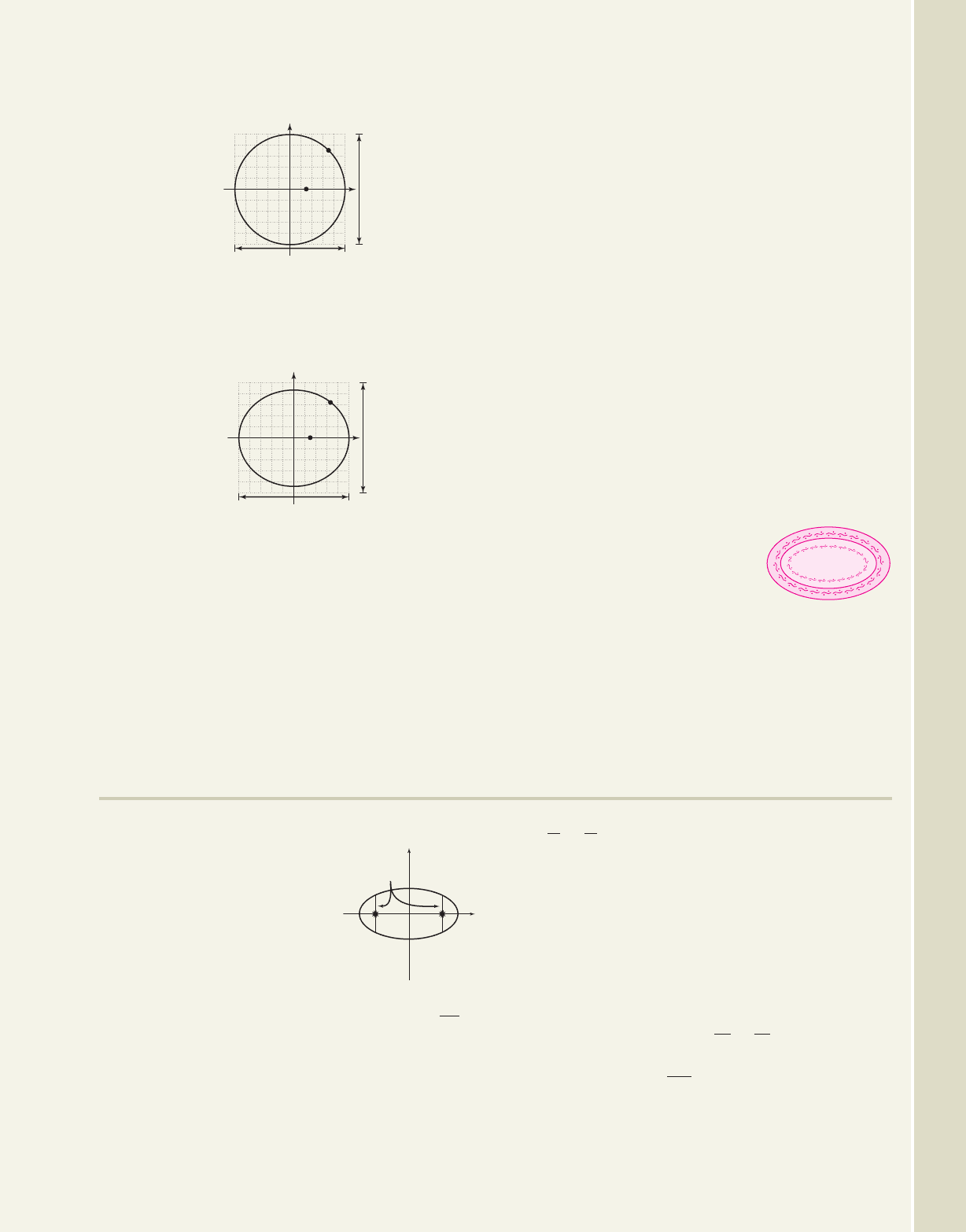
72. Orbit of Pluto: The approximate orbit of the dwarf
planet Pluto is shown in the figure given. Find an
equation that models this orbit.
73. Planetary orbits: Except for small variations, a
planet’s orbit around the Sun is elliptical with the
Sun at one focus. The aphelion (maximum distance
from the Sun) of the planet Mars is approximately
156 million miles, while the perihelion (minimum
distance from the Sun) of Mars is about
128 million miles. Use this information to find
the lengths of the semimajor and semiminor axes,
rounded to the nearest million. If Mars has an
orbital velocity of 54,000 miles per hour
x
y
Pluto
Sun
3650 million miles
3540 million miles
x
y
Mercury
Sun
72 million miles
70.5 million miles
(1.296 million miles per day), how many days does
it take Mars to orbit the Sun? (Hint: Use the
formula from Exercise 64).
74. Planetary orbits: The aphelion (maximum
distance from the Sun) of the planet Saturn is
approximately 940 million miles, while the
perihelion (minimum distance from the Sun) of
Saturn is about 840 million miles. Use this
information to find the lengths of the semimajor
and semiminor axes, rounded to the nearest
million. If Saturn has an orbital velocity of
21,650 miles per hour (about 0.52 million miles
per day), how many days does it take Saturn to
orbit the Sun? How many years?
75. Area of a race track: Suppose the Toronado 500
is a car race that is run on an elliptical track. The
track is bounded by two ellipses with equations of
and , where x
any y are in hundreds of yards. Use the formula given
in Exercise 63 to find the area of the race track.
76. Area of a border: The table
cloth for a large oval table is
elliptical in shape. It is
designed with two concentric
ellipses (one within the other)
as shown in the figure. The equation
of the outer ellipse is and the
equation of the inner ellipse is
with x and y in feet. Use the formula given in
Exercise 63 to find the area of the border of the
tablecloth.
4x
2
16y
2
64
9x
2
25y
2
225,
9x
2
25y
2
9004x
2
9y
2
900
10-21 Section 10.2 The Circle and the Ellipse 939
Exercise 71
Exercise 72
Exercise 76
EXTENDING THE THOUGHT
77. When graphing the conic
sections, it is often helpful
to use what is called a focal
chord, as it gives additional
points on the graph with very
little effort. A focal chord is
a line segment through a
focus (perpendicular to the
major or transverse axis),
with the endpoints on the graph. For an ellipse,
the length of the focal chord is given by ,
where m is the length of the semiminor axis, and n
is the length of the semimajor axis. The focus will
always be the midpoint of this line segment. Find
the length of the focal chord for the ellipse
L
2m
2
n
and the coordinates of the endpoints.
Verify (by substituting into the equation) that these
endpoints are indeed points on the graph, then use
them to help complete the graph.
78. For the equation
, does the equation appear to be that of a
circle, ellipse, or parabola? Write the equation in
factored form. What do you notice? What can you
say about the graph of this equation?
79. Verify that for the ellipse , the length of
the focal chord is .
2b
2
a
x
2
a
2
y
2
b
2
1
28
6x
2
36x 3y
2
24y 74
x
2
81
y
2
36
1
x
y
Focal
chords
Exercise 77
College Algebra & Trignometry—
cob19529_ch10_0928-0940.qxd 12/8/08 3:01 PM Page 939 epg HD 049 :System Folder:Appearance:Coburn Don't del-book 2 :Coburn_do_t del-ch10:
